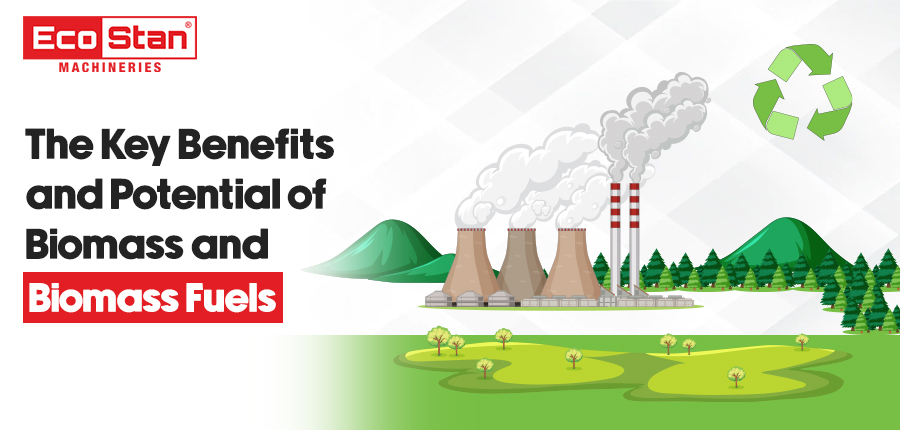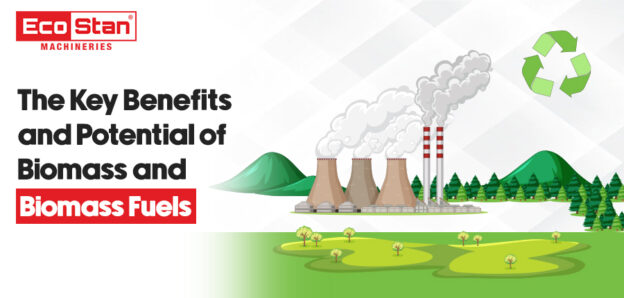ECOSTAN® The Key Benefits and Potential of Biomass and Biomass Fuels

Biomass fuel, derived from organic matter such as plants or animals, is rapidly becoming one of the world’s most rapidly expanding fuel sources. A key advantage of biomass fuel is its carbon neutrality. Carbon dioxide is extracted during the organism’s life cycle, preventing additional carbon dioxide emissions during combustion.
Trees, for example, absorb carbon dioxide during photosynthesis. When you burn wood, carbon dioxide is released, while combustion occurs because of oxygen, causing no environmental harm. As a result, biomass fuel is an ideal renewable energy source compared to fossil fuels, as they cause no environmental damage.
There are multiple methods for acquiring biomass fuel as a natural energy source. It is worth noting that industries utilizing wood as fuel generally do not cut down entire trees but instead employ waste products such as rotten wood, branches, and leaves. After crushing these waste products, transport them into the biomass power plants to make a biomass briquette.
Energy Production
There are various methods to produce energy using biomass. One approach is to burn biomass directly to generate heat, which we can use for space and water heating.
Another technique is to convert biomass into liquid or gaseous fuels like biofuels and biogas through bioconversion. Bioconversion involves breaking down the organic matter in biomass using chemical or biological processes, producing ethanol, biodiesel, other liquid biofuels, and methane-rich biogas.
You can also use biomass to generate electricity through biomass combustion in power plants rather than fossil fuels. Biomass power plants use a similar process to traditional power plants, but they burn biomass instead of fossil fuels to generate steam, which then powers turbines to produce electricity.
Briquettes are another form of energy that you can get from biomass. These are the blocks that form after compressing the organic materials. The process involves compressing the waste, such as sawdust or agricultural waste, into small blocks that are easy to transport and use.
Briquettes burn more efficiently than loose biomass; you can use them instead of traditional fossil fuels like coal and wood. This makes them a valuable alternative for heating and cooking in areas with scarce or expensive conventional fuels.
In addition, you can convert biomass into bio-oil, which can be used to produce a range of chemicals and materials after further processing. This process is known as pyrolysis.
This fuel is a versatile energy source that you can use in various ways to generate heat, power, and fuels while reducing carbon emissions.
Facts about Biomass Fuels:
- It is the world’s largest renewable energy source, accounting for nearly 10% of global energy use.
- It is a carbon-neutral energy source. The carbon dioxide offsets the carbon dioxide that emits during biomass combustion and is generally absorbed during its growth.
- You can get this environmentally friendly fuel from various sources, including agricultural waste, forestry residues, energy crops, and municipal solid waste.
- Briquettes are one of the ideal energy-producing sources that you can prepare using this agricultural waste.
- This fuel is used for various energy applications, including heating, cooling, electricity generation, and transportation.
- It is a flexible energy source that you can use to meet various energy needs. One can burn it directly for heat or convert it into multiple fuels, including ethanol, biodiesel, and biogas.
- It can help to reduce greenhouse gas emissions and promote sustainable development.
By replacing fossil fuels with biomass, we can reduce our dependence on non-renewable resources and mitigate the impacts of climate change.
Here are some exciting facts about biomass:
1. Reducing Carbon Dioxide Emissions through Biomass Utilization
It can be pivotal in achieving the EU’s 2030 renewable energy targets. However, for it to be an effective tool in reducing ecological footprints, it is crucial that biomass production, processing, and usage are sustainable and efficient. This is necessary to prevent environmental damage such as deforestation, soil degradation, and biodiversity loss.
2. Doubling of Modern Bioenergy Consumption Predicted in the Next 20 Years
Developing countries use two-thirds of biomass for domestic cooking and heating rather than fossil fuels globally. Modern bioenergy accounts for approximately 6% of total electricity production in Europe.
The International Renewable Energy Agency (IRENA) estimates that bioenergy production in the EU-28 will increase to 324 TWh in 2030, up from 128 TWh in 2010, according to REmap analysis data.
3. Green Energy in a Brick- Biomass briquettes
One fact about briquettes is that they reduce dependence on non-renewable sources, help reduce waste, and promote a circular economy. Moreover, briquettes produce less greenhouse gas emissions and are more efficient than traditional fossil fuels.
4. Human Waste as a Viable Fuel Source
The proper equipment can process municipal waste and turn it into a highly efficient energy source. Recycling and energy recovery of waste already have numerous advantages over landfilling.
Conclusion
India has abundant biomass reserves, around 500 million metric tons annually. We use over 120 to 150 million metric tons of biomass fuel for energy production.
The progress in biomass energy production in India will provide social and economic benefits to rural and urban areas. Briquettes derived from biomass are also a cost-effective and eco-friendly energy source.
To search for a high-quality briquette machine, you must visit Ecostan.


 Click to Play Video
Click to Play Video